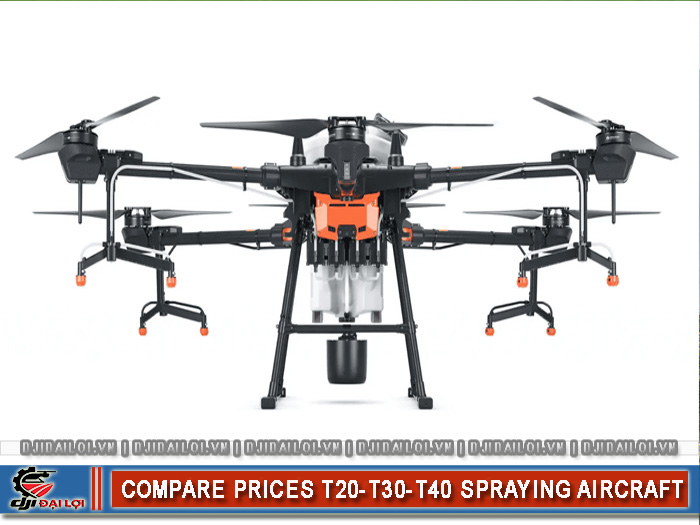
The DJI Agras series is a line of unmanned aerial vehicles designed for automated pesticide spraying. These drones feature AI systems, multi-directional radar, and RTK positioning, enabling precision spraying while saving up to 30% pesticide and 40% water compared to manual methods.
Among current models, the DJI Agras T20, T30, and T40 represent three productivity tiers. The T20 is considered the most balanced between cost and performance—ideal for medium-scale farms and cooperatives.
These three DJI Agras drones are sequentially upgraded in tank capacity, payload, and technology:
Due to these differences, the T20 price is 20–40% lower than the T30 and T40, making it a popular choice among small and mid-sized farmers.
Price variations come from four main factors:
Thanks to a good balance of technology and affordability, the DJI Agras T20 price remains the most competitive in the mid-range segment.
|
Model |
Tank capacity |
Max spray rate |
Spraying efficiency (ha/hour) |
|---|---|---|---|
|
T20 |
20 L |
6.0 L/min |
10–12 |
|
T30 |
30 L |
8.0 L/min |
12–14 |
|
T40 |
40 L |
10.0 L/min |
14–16 |
From the table above, the T20 delivers stable performance of 10–12 ha/hour, sufficient for farms of 10–30 ha. The T30 and T40 serve larger-scale operations but require significantly higher investment and maintenance costs.
Cooperatives often note that the T20 is more energy-efficient and easier to maintain—an advantage for reducing total operating costs.
Radar and GPS RTK allow positioning accuracy within ±1 cm, preventing over-spray or missed areas.
The T40 and T30 include omnidirectional radar, while the T20 uses basic front-rear sensors yet still maintains consistent performance on flat terrain.
Thanks to these features, the T20’s spraying accuracy reaches 90–95% of higher models, while costing only 60–70% as much.
|
Model |
Reference price (VND) |
Ideal user |
|---|---|---|
|
DJI Agras T20 |
190–240 million |
Small farms, cooperatives |
|
DJI Agras T30 |
270–320 million |
Mid-sized farms |
|
DJI Agras T40 |
380–450 million |
Agribusiness enterprises |
Thus, the T20 remains the most economical option especially for those seeking high efficiency at a lower initial cost.
For small-scale production, the T20 offers the best cost-to-performance ratio.
Additional factors affecting agricultural drone prices:
Overall, the T20 maintains a stable price due to common spare parts and lower maintenance costs.
Operating expenses—including batteries, spraying liquids, labor, and maintenance—average 20–25 million VND/year for the T20, compared to 30 million for the T30 and 40 million for the T40.
Thanks to its reasonable price, the T20 allows small investors to recover capital quickly through rental spraying services and stable productivity.
With an investment under 250 million VND, the T20 is the most efficient option for small to medium farms.
Due to its affordability, the T20 remains the top-selling drone in Vietnam’s agricultural market.
Choosing the right model requires balancing performance, terrain, and the current T20 drone price to maximize return on investment.
Buy only from authorized DJI distributors offering 12–24-month warranties and UAV training. Some dealers also provide maintenance and RTK software updates to ensure stable long-term operation.
|
Model |
Key advantages |
Limitations |
Best for |
|---|---|---|---|
|
T20 |
Low price, easy maintenance, ideal for small areas |
Smaller tank, basic radar |
Small farms, cooperatives |
|
T30 |
Higher performance, stable spraying |
Higher cost than T20 |
Medium farms |
|
T40 |
Advanced AI, 360° camera, strong output |
High cost, complex operation |
Large enterprises |
Overall, the T20 remains the best value model, balancing cost and efficiency for most users.
In summary, the T20 provides the best cost-performance ratio for small farms, while the T30 and T40 cater to larger operations seeking advanced automation. Understanding these price and capability differences ensures a smart investment aligned with your production goals.
Yes. Prices may differ by 5–10% depending on transport and dealer policies. The Mekong Delta region often offers lower prices due to higher demand.
New genuine models are recommended for full warranty and software updates. Used drones are only advisable with verified maintenance records and technical inspection.
No. Hardware, tank capacity, and sensors differ. However, T20 owners can expand capacity by adding another unit or upgrading through authorized DJI trade-in programs.
Usually not. The base price covers only the drone body. Batteries, fast chargers, and accessories add about 15–20% to total investment cost.
Yes. Many cooperatives offer T20 spraying services at 120,000–150,000 VND/ha, a cost-effective option for smallholders without sufficient capital for purchase.